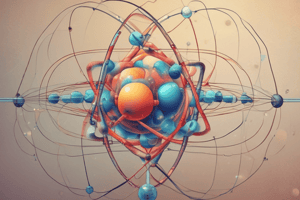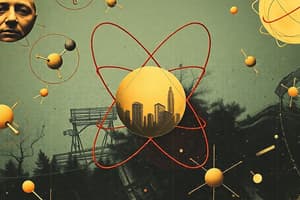Podcast
Questions and Answers
Flashcards are hidden until you start studying
Study Notes
Atomic Structure
-
Atom Basics:
- Smallest unit of matter.
- Composed of protons, neutrons, and electrons.
-
Subatomic Particles:
- Protons: Positively charged, located in the nucleus.
- Neutrons: No charge, also in the nucleus.
- Electrons: Negatively charged, orbiting the nucleus in energy levels.
-
Atomic Number:
- Number of protons in an atom; determines the element.
-
Mass Number:
- Total number of protons and neutrons in the nucleus.
-
Isotopes:
- Atoms of the same element with differing numbers of neutrons.
Periodic Table
-
Organization:
- Elements arranged by increasing atomic number.
- Rows (periods) and columns (groups or families) based on similar properties.
-
Groups:
- Vertical columns, elements in the same group have similar chemical properties.
- Examples: Group 1 (Alkali metals), Group 17 (Halogens).
-
Periods:
- Horizontal rows indicating the number of electron shells.
-
Metals, Nonmetals, and Metalloids:
- Metals are conductive, malleable, and ductile (left side).
- Nonmetals are poor conductors and brittle (right side).
- Metalloids have properties of both.
-
Lanthanides and Actinides:
- Two rows of elements placed below the main body; rare earth metals and radioactive elements.
Chemical Bonding
-
Types of Bonds:
-
Ionic Bonding:
- Formed when electrons are transferred from one atom to another.
- Typically between metals and nonmetals.
- Results in the formation of charged ions.
-
Covalent Bonding:
- Formed when atoms share electrons.
- Usually occurs between nonmetals.
- Molecules can be polar (unequal sharing) or nonpolar (equal sharing).
-
Metallic Bonding:
- Characterized by a 'sea of electrons' around metal cations.
- Provides conductivity and malleability.
-
-
Importance of Chemical Bonds:
- Determine the structure and properties of compounds.
- Influence reactivity and stability of substances.
-
Molecular vs. Empirical Formula:
- Molecular formula indicates the actual number of atoms in a molecule.
- Empirical formula shows the simplest ratio of elements in a compound.
Atomic Structure
- An atom is the smallest unit of matter, composed of protons, neutrons, and electrons.
- Protons are positively charged particles found in the nucleus of an atom.
- Neutrons are neutral particles that also reside in the nucleus.
- Electrons carry a negative charge and orbit the nucleus in defined energy levels.
- The atomic number represents the number of protons in an atom, defining the element.
- Mass number is the sum of protons and neutrons in the nucleus, indicating the atom's total mass.
- Isotopes are variations of the same element that have different numbers of neutrons, resulting in different mass numbers.
Periodic Table
- The periodic table organizes elements by increasing atomic number, reflecting their unique properties.
- Elements are arranged in rows called periods and columns known as groups or families; similar chemical properties are found within groups.
- Group 1 contains alkali metals, while Group 17 consists of halogens, both displaying distinct chemical behavior.
- Periods signify the number of electron shells an element possesses.
- Metals are typically found on the left side of the table and exhibit high conductivity, malleability, and ductility.
- Nonmetals, located on the right side, are generally poor conductors and brittle in nature.
- Metalloids possess qualities of both metals and nonmetals, serving as a bridge in the table.
- Lanthanides and actinides are two special rows of elements, known as rare earth metals and radioactive elements, placed below the main periodic table.
Chemical Bonding
- Chemical bonds are crucial in defining the structure and properties of compounds.
- Ionic bonding occurs when electrons transfer from one atom to another, typically between metals and nonmetals, forming charged ions.
- Covalent bonding involves the sharing of electrons between atoms, primarily occurring between nonmetals; these bonds can be polar or nonpolar based on electron sharing.
- Metallic bonding features a 'sea of electrons' that surrounds metal cations, enabling conductivity and malleability in metals.
- The molecular formula of a compound indicates the actual number of atoms, whereas the empirical formula represents the simplest ratio of the different elements present.
Covalent Bond Formation
- A covalent bond forms when two atoms share one or more pairs of electrons, leading to chemical stability.
Types of Covalent Bonds
- Single Bond: Involves one pair of shared electrons (e.g., H₂ molecule).
- Double Bond: Involves two pairs of shared electrons (e.g., O₂ molecule).
- Triple Bond: Involves three pairs of shared electrons (e.g., N₂ molecule).
Electron Sharing
- Atom stabilization occurs through electron sharing, which typically happens between nonmetals with similar electronegativities.
Molecular Orbital Theory
- Electrons occupy molecular orbitals created by overlapping atomic orbitals, with bonding orbitals being lower in energy compared to antibonding orbitals.
Bond Length and Strength
- As the number of shared electron pairs increases, bond length decreases (single bond > double bond > triple bond), while bond strength increases correspondingly.
Polar vs. Nonpolar Covalent Bonds
- Nonpolar Covalent Bond: Electrons are shared equally, seen in molecules like Cl₂.
- Polar Covalent Bond: Electrons are shared unequally due to electronegativity differences, such as in H₂O.
Lewis Structures
- Lewis structures visually depict covalent bonds using dots for electrons, aiding in predicting the molecular arrangement.
Resonance
- Some molecules can’t be accurately represented by a single Lewis structure, leading to resonance structures that illustrate potential configurations of electron sharing.
Factors Influencing Bond Formation
- Electronegativity: Influences the bond's polarity, affecting how electrons are shared.
- Atomic Size: Larger atoms typically form longer bonds because of the increased distance between their nuclei.
Bonding and Molecular Geometry
- The arrangement of bonds influences the shape of the molecule, as described by VSEPR theory. Common geometries include linear, bent, tetrahedral, and trigonal planar, determined by the number of shared electron pairs.
Studying That Suits You
Use AI to generate personalized quizzes and flashcards to suit your learning preferences.




